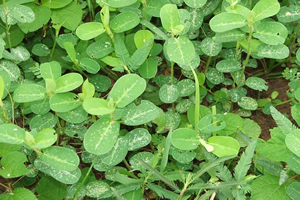| HOME > View Blog > |
View Blog
Friday, Apr 01, 2016 12:00am

Alyce clover or Alyceclover (Alysicarpus vaginalis)

Alyce clover is a warm season annual legume. It is a palatable and nutritious deer forage. It holds up well to browsing. It is very productive from spring until early fall. It is widely adapted across the Southern US. It does well on most moderate and well-drained soils. It does well on clay soils and does best on sandy loam soils. It is fairly drought tolerant but does not tolerate wet soils. It can tolerate pH as low as 5.5 but will do best with soil pH is between 6.0 and 6.5. Plant April to June. Because Alyce clover is a legume, the seed should be inoculated with Rhizobium bacteria (EL Type Inoculant) before it is planted. Broadcast seed at a rate of 20 lbs. per acre. In the absence of a soil test, fertilize with 100 lbs. per acre of 0-30-30 fertilizer at establishment.
Seedbed preparation will help ensure good establishment. Disk and then smooth the seed bed by rolling with a cultipacker or dragging with a drag harrow. Do not disk seed in. Lightly drag the seed in with a drag harrow to cover the seed. Cover seed ¼ inch deep.
Alyce clover can be established by over seeding cool season food plots or grasslands (e.g., pasture or right of ways). Control competition via grazing, mowing and or herbicide prior to planting. Lightly disk, broadcast seed and then lightly disk again to incorporate the seed into the soil.
Alyce clover is often planted in combination with Cowpeas. When planting in combination with Cowpeas decrease the seeding rate by ½. Do not mix the Alyceclover and the larger Cowpeas seed together when broadcasting the seed. The smaller Alyceclover seed will settle to the bottom of the seeder and will not be evenly distributed. Broadcast separately and then cover seed. Cover the mixture to a depth of ¼ to ½ inches by lightly dragging with a drag harrow.
